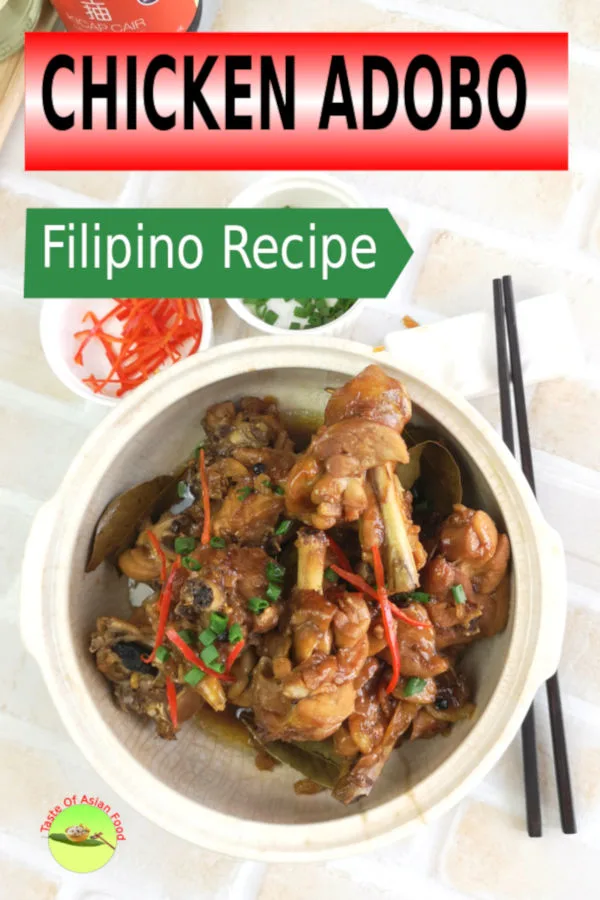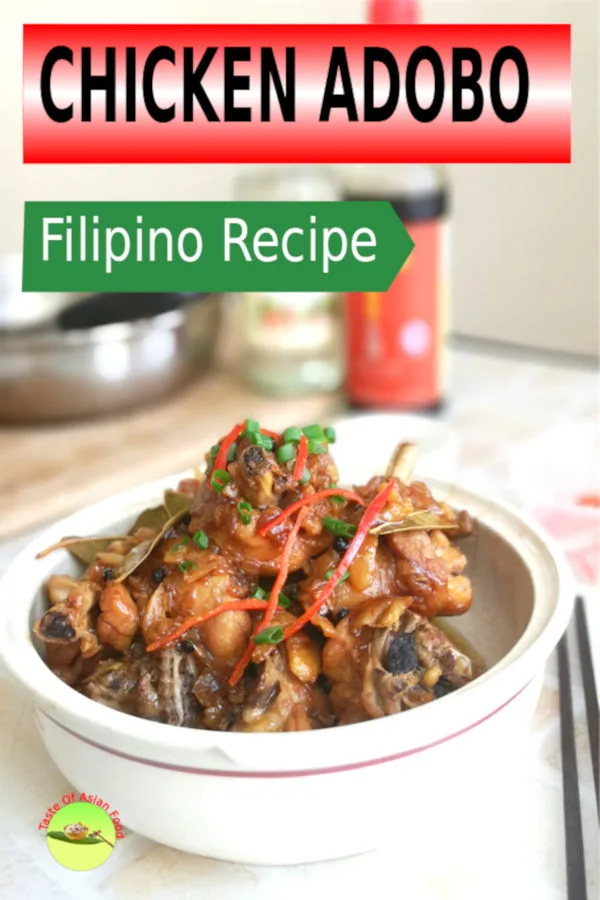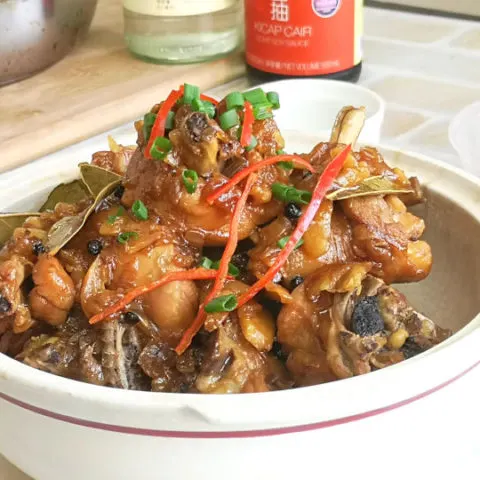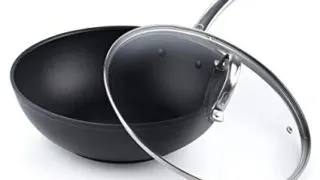Chicken adobo is perfect for anyone who doesn’t want to spend too much time to cook, yet delicious and appeal to everyone. It is likely to be the most popular Filipino dish worldwide. The chicken is braised with soy sauce and vinegar and flavor with bay leaves and other herbs. The recipe attained massive popularity because of its fabulous taste and most of all, quick to prepare.
I made this dish a few years ago and today make it again and improvise it with a few twists. It turned out very well with the perfect balance of saltiness and sourness. This article shows you how to prepare chicken adobo step-by-step in detail.

Note: This post may contain affiliate links. Please read my privacy policy for more info. I may receive commissions for purchases made through links in this post.
Chicken adobo is a dish made up of vinegar mixed with soy sauce and garlic. Chicken is then marinated and slow cooked in the sauce. Sometimes other meats are used as well. Chicken adobo is served over rice and eaten on all occasions whether it be at a typical meal or special feasts.
Adobo is so popular in the Philippines that it has unofficially been called the national dish of the Islands.
How to cook Chicken adobo- step by step
1. Marinate the chicken for better taste
You can use any part of the chicken to prepare chicken adobo, but my preferred part is the chicken thigh or leg, bone-in, and skin-on.
I like the texture of dark meat, but you can also use chicken breast meat for sure. The big difference is if you use any chicken chunks with bone, the bone will release additional flavor to the braising liquid during cooking. It is the same process happening when we make chicken stock. This process gives you lots of other flavors that you will miss out if you are using breast meat.
I have also seen some recipe includes chicken bouillon into the recipe. It is not necessary if you are using bone-in chicken chunks. You can immediately taste the difference with the real deal comparing with any artificial flavoring enhancer.
Marinate the chicken chunks
Marinate the chicken with light soy sauce, white vinegar, sugar, and salt for at least two hours to let the flavor penetrate the interior of the chicken chunks. You may marinate longer than this (even overnight), and there will be even better!
If you intend NOT to marinate the chicken for some reasons, there is a workaround way, although it is not perfect. First, braise the chicken for a longer time in the following step to let the chicken absorb more flavor from the braising liquid. Secondly, you can prepare chicken adobo in advance as it can be kept for a few days in the refrigerator. The chicken will continue absorbing the flavor from the braising liquid, and that is why overnight chicken tastes better than the freshly cooked chicken adobo.
The essential seasoning ingredients for chicken adobo is the soy sauce and vinegar. You will find that the quantity of these ingredients differs significantly from one recipe to another. I use 80ml of soy sauce and 40ml of vinegar for one kg of chicken. I also have seemed some people use 60 ml of soy sauce and vinegar. Therefore, there is no one fix rule to follow, and it follows what your tastebuds tell you to make your decision.
I use only light soy sauce for this recipe. Since I pan-fried the chicken first before braising, the color is dark enough and dark soy sauce become unnecessary. As for the vinegar, I use rice vinegar, but any other white vinegar is just equally suitable.
As for the sugar, some people like to add some brown sugar, but I hardly taste any different from using only white sugar.
2. Pan-fried the chicken and saute the aromatic
Pan-fried the chicken before braising will add a layer of flavor to the chicken due to the Maillard reaction and caramelization of the sugar. This step can create a taste that will not happen no matter how long you braise the chicken.
Next, I will saute the crushed garlic until they turn slightly brown. Sauteeing can make the garlic more aromatic as compared to adding it to the marinade.
When the garlic starts to turn slightly brown, add the ginger and diced onion and continue to sweet it until translucent.
3. Braise the chicken
Next, add the pan-fried chicken back to the pan. And the remaining steps are straight forward.
- Add the remaining ingredients and return the marinade to the pan.
- Braise the chicken over low heat for ten minutes, and then turn the chicken over for another ten minutes.
- Put the lid on while braising the chicken and there is no need to add water.
When it is done, do a final taste test. You still can adjust the saltiness, sourness, and sweetness at this point. Some people prefer to cook it down to become a thick sauce, and others would prefer to be more diluted and drizzle it on to steamed rice.
Note: If you like braised chicken like this recipe, please check out another famous braised chicken recipe called Three Cups Chicken which I published recently.
The Origin Of Adobo Chicken
The name “adobo” is obviously of Spanish origin. However, the dish goes back far before the Spaniards took control of the islands. The indigenous population had been making adobo sauce for quite some time before Spanish colonization.
The method to cook chicken adobo dates back to the “classic” period of the Philippines (between 900 and 1500). The original name of the dish, however, has unfortunately been lost over time and even the native population of the Philippines refers to the dish as adobo.
It seems that the recipe resulted from the practice of preserving meat with vinegar and salt for it to keep longer. It keeps for a long time even without refrigeration. With time soy sauce was introduced by the Chinese and it found its way into the adobo sauce.
In the sixteenth century when the Spanish colonized the Philippines, they discovered this delicious process of cooking and liked it enough to name it and write about it. The name they chose, adobo, basically means marinade. However, this form of marinating is quite different from the traditional Spanish “adobo.”

Chicken Adobo is a versatile dish
The traditional way of preparing chicken adobo was to simmer the chicken in a clay pot using just the right mixture of vinegar, crushed garlic, soy sauce, bay leaves, and peppercorns. It is more common in our days to use a metal wok or pan. However, some still use clay pots over coals.
Variations
Even though the basic idea seems simple, there are many recipes and variants of the sauce. Many Filipino women pride themselves in their “superior’ way of preparing the dish. Many times different members of the very same household will have their own “tricks” on cooking a “better” adobo.
Type of vinegar. The main ingredient is always vinegar. However, the type of vinegar may often change. In the Philippines coconut vinegar, cane vinegar, and rice vinegar can all be readily found, and use to prepare chicken adobo.
Type of meat. You can pork, beef or even duck in replace of chicken. It also has a side margin to play with, i.e., varied the amount of each seasoning ingredients to create the taste you like.
Vegetables. Some recipes even include items like potatoes, carrots, and pineapples and you can see how versatile this dish can be!
Most of all, you can make chicken adobo in advance, keep in the refrigerator a few days which make it perfect for party and picnics.
Different ways to cook chicken adobo
There is a version of chicken adobo that does not use soy sauce and therefore does not take on a black flavor. This variation is often referred to as adobong puti or white adobe. This version is considered the closest to the original recipe before the Chinese introduced soy sauce.
Some choose to use other ingredients, such as hot peppers, red peppers, onions, olive oil, potatoes, or even pineapple for chicken adobo. Some prefer to brown it in the oven before serving it, others deep fry it or grill it. The browning that results does improve the dish.
Chicken adobo from different regional areas has its uniqueness. For example, in the Zamboanga, Luzon, and the Muslim regions it is common to cook it with coconut milk. In Cavite, they even add mashed pork liver! In the Laguna region turmeric is used, this gives the plate a yellow color.

Chicken Adobo Recipe
Chicken adobo is the most popular Filipino dish worldwide. It is braised with soy sauce and vinegar and flavor with bay leaves and other herbs. Learn to make it in 3 simple steps in this recipe.
Ingredients
Marinade the chicken
- 1 kg of chicken
- 40 ml of rice vinegar
- 80 ml of light soy sauce
- 30 g of sugar
- 10 g of salt
Other ingredients
- 6 cloves of garlic crushed
- 100 g of onion, cut to small pieces
- 10 g of ginger, cut to thin slices
- 1 dry chili
- 4 bay leaves
- 1 tbsp of black peppercorn
- 50 ml of vegetable oil
For garnish
- Spring onion
- Red Chili
Instructions
- Marinate the chicken with the Marinade as shown in the ingredient list above. Marinate for two hours or longer.
- Heat the oil in the wok. Saute the crushed garlic until slightly brown.
- Add onion and ginger until fragrant.
- Put in marinated chicken and brown both sides, about five minutes.
- Pour in the remaining marinate int the wok and add some extra water.
- Add the red chili, bay leaves, and black peppercorns.
- Simmer the chicken for about 20 minutes or until the internal temperature reaches 160 degree Celsius. Flip the chicken over for even cooking.
- Season the Chicken based on the amount of sauce.
- Once it is done, remove the chicken from the wok and place it on a serving plate.
- Heat the remaining marinade in the wok until it becomes slightly thickened.
- Pour the sauce over the chicken.
- Garnish with spring onions and red chili
Notes
If you encounter any audio / visual problem of viewing this video, you can view it from YouTube by clicking this link, which will open in a new tab.
Nutrition Information:
Yield: 4 Serving Size: 4 seervingsAmount Per Serving: Calories: 1006Total Fat: 62gSaturated Fat: 16gTrans Fat: 0gUnsaturated Fat: 38gCholesterol: 285mgSodium: 3616mgCarbohydrates: 30gFiber: 3gSugar: 12gProtein: 81g
This data was provided and calculated by Nutritionix on 5/11/2019
Things that you may need for Chicken Adobo
You may need the following items to prepare this recipe.
Cooks Standard 02591 Flat Bottom with Lid 11-Inch Hard Anodized Nonstick Wok Stir Fry Pan, Black
Nonstick performance for easy food release/tossing, cleaning, and allows for healthy cooking
Tempered glass lid to view food; wide and deep to hold a large amount for multiple uses
Lee Kum Kee Premium Light Soy Sauce - 150ml (5.27 fl oz)
150ml.
Lee Kum Kee.
Heinz Distilled White Vinegar, 64 oz
Collected through selective boiling and condensation from a fermented mixture of American-grown corn and clear water.
Just the right amount of acidic (5%) for canning and pickling.
Clay Curry Pot - Large - 9 Inch
Traditional Indian Clay Curry Pots from India.
Hand made with 100% lead free unglazed clay
Great for Making traditional fish curry.
Make sure to buy from Ancient.Cookware to ensure quality.





Jared
Tuesday 13th of October 2020
This filipino dish recipe brings back memories of my grandma who used to make delicious adobo whenever we went to their house.
Arpita Patel
Saturday 18th of April 2020
I saw this recipe on pinterest and followed the link here. The presentation was lovely and wanted to make something new for neighbors, one of whom is filipino. It was a hit! Really wonderful flavors served with a side of roasted brussels and a nice cucumber dill salad for something light. Thanks so much will definitely be adding to my go to recipes
KP Kwan
Sunday 19th of April 2020
Hi Arpita, Thank you so much for trying this recipe and great to know that you and your neighbor love it. Cheers! KP Kwan
KP Kwan
Friday 3rd of June 2016
Hi, this is KP Kwan. I am happy to see you at this comment area, as you have read through my recipe. I am happy to reply any questions and comments as soon as possible.